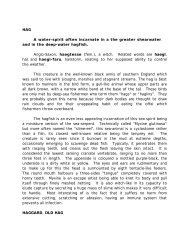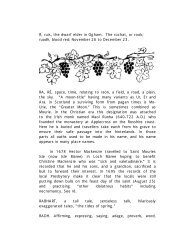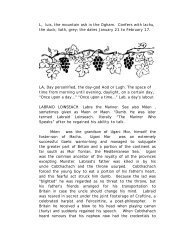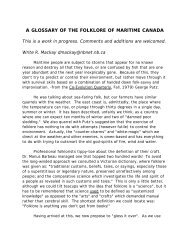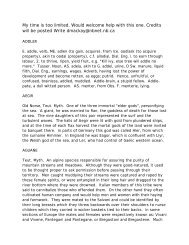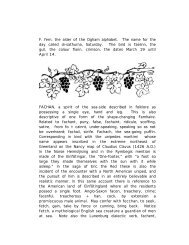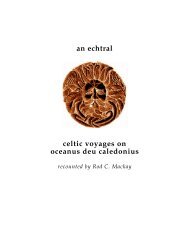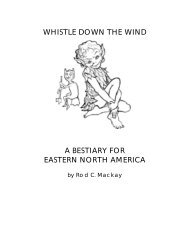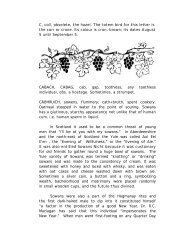G, GORT, ivy in the Ogham alphabet. The bird ... - Rodney Mackay
G, GORT, ivy in the Ogham alphabet. The bird ... - Rodney Mackay
G, GORT, ivy in the Ogham alphabet. The bird ... - Rodney Mackay
Create successful ePaper yourself
Turn your PDF publications into a flip-book with our unique Google optimized e-Paper software.
names visited upon <strong>the</strong> Scots by <strong>the</strong>ir Irish enemies. If this<br />
is so, it is likely that sea-far<strong>in</strong>g Scots numbered survivors<br />
from <strong>the</strong> old Fomorian sea-k<strong>in</strong>gdoms <strong>in</strong> <strong>the</strong> west. It is<br />
almost a homely to say that pre-Roman Brita<strong>in</strong> was<br />
<strong>in</strong>habited by a people “who were ma<strong>in</strong>ly Celtic and that <strong>the</strong><br />
Celts reached this country <strong>in</strong> three pr<strong>in</strong>cipal waves of<br />
immigration. One wave came to <strong>the</strong> east coast by way of<br />
<strong>the</strong> North Sea, ano<strong>the</strong>r by way of <strong>the</strong> Gaul to <strong>the</strong> South of<br />
England, and <strong>the</strong> third from <strong>the</strong> Cont<strong>in</strong>ent by way of<br />
Irealand.” This is <strong>the</strong> view of most historians, although<br />
<strong>the</strong>re is no written magic to back up <strong>the</strong> idea that all <strong>the</strong><br />
peoples of <strong>the</strong> islands arrived from <strong>the</strong> east. In <strong>the</strong> black<br />
well of times long past historians are as much adrift as<br />
mythologists, and many of <strong>the</strong>se have a contrary op<strong>in</strong>ion.<br />
<strong>The</strong>se is <strong>the</strong> problem of Irish Gaelic, which is still<br />
considered <strong>the</strong> most antique of all <strong>the</strong> Celtic tongues.<br />
Aryan scholars say that <strong>the</strong> Indo-European tongues started<br />
<strong>in</strong> nor<strong>the</strong>rn India and spread slowly from <strong>the</strong>re westward.<br />
Professor Schleider (1874) that this Celtic tongue has <strong>the</strong><br />
appearance of a separation from <strong>the</strong> supposed root<br />
(Sanskrit) at a later date than <strong>the</strong> Cymric and Brythonic<br />
tongues, but <strong>the</strong>y are supposedly of more recent evolution.<br />
Worse still, Gaelic has <strong>the</strong> look of be<strong>in</strong>g more closely allied<br />
with Lat<strong>in</strong> than any of <strong>the</strong> supposed Indo-European<br />
affiliates. <strong>The</strong>se idiosyncracies suggest that Gaelic might<br />
have spread from Ireland to <strong>the</strong> east, where it collided<br />
with, and became associates of <strong>the</strong> west-bound language<br />
which is now preserved <strong>in</strong> English, German and <strong>the</strong><br />
Scand<strong>in</strong>avian tongues.<br />
We are <strong>the</strong>n left with <strong>the</strong> question of where <strong>the</strong> Gaelic<br />
vocabulary orig<strong>in</strong>ated and are led back to <strong>the</strong> fact that <strong>the</strong><br />
Celto-Iberian tongues have “more analogies with American<br />
types than with any o<strong>the</strong>r.” In his book, On <strong>the</strong> Phenomena<br />
of Hybridity <strong>in</strong> <strong>the</strong> Genus Homo,, Paul Broca (1869) said that<br />
“Of all Europeans, we must provisionally hold <strong>the</strong> Basques<br />
to be <strong>the</strong> oldest <strong>in</strong>habitants of our quarter of <strong>the</strong> world.” He<br />
said that <strong>the</strong>ir language, <strong>the</strong> Euscara, “has some common<br />
traits with <strong>the</strong> Magyr (Hungary), Osmanli, and o<strong>the</strong>r dialects



